Have you been looking for a very comprehensive InMotion Hosting vs Bluehost comparison for 2025? Well, you are not alone. Despite being part of the best web hosting services in 2025, many users are wondering whether Bluehost is better than InMotion or not. This is mostly fueled by the fact that while Bluehost is more popular, many experts are constantly commending InMotion for its outstanding services.
As a result, it became necessary to have a Bluehost vs InMotion Hosting side-by-side comparison to know the better option. This article will reveal how each web host performs in various aspects and which one is superior.
Bluehost vs InMotion Hosting: General Info
Bluehost is a very popular web host in 2025. It has been around for about two decades and is widely used for hosting different types of sites. Bluehost makes it easy for beginners to create their first site by providing affordable plans and an accessible one-click app installer. Aside from that, it has some special features that generally enhance the performance of a website.
InMotion is also a notable hosting provider in the industry. It is one of the high-performance web hosts that provide affordable highly optimized hosting environments for sites and applications. Similarly, InMotion can power any kind of website. However, it has servers optimized specifically for WordPress websites.
InMotion Hosting vs Bluehost Comparison Summary
| Yardsticks | InMotion Hosting | Bluehost |
|---|---|---|
| Overall Rating | 8.8/10 | 7.7/10 |
| Starting Price | $2.49 | $2.95 |
| Hosting Types | Shared/WP, Managed WordPress, VPS, Reseller, Dedicated Server, and Cloud | Shared/WP, VPS, and Dedicated Server |
| Control Panel | AMP with cPanel Integration & Platform i | Sleek Dashboard with cPanel Integration |
| Uptime | 99.995% | 99.963% |
| Loading Speed | 530 ms | 1.4 s (1400 ms) |
| Security | SSL, Automated Backup, and Malware Scanning, | SSL, DDoS Protection, Firewalls, Hack & Malware Protection, and Automated Backups |
| Support | 24/7 Live Chat, Phone Calls, Ticketing, and Skype | 24/7 Live Chat, Phone Calls, and Ticketing |
| Money-back Guarantee | 90 Days | 30 Days |
InMotion Hosting vs Bluehost: Which Has More Hosting Types & Plans?
When choosing a provider for your website or application in 2025, noting the types of hosting services they provide is paramount.
Web hosts provide different types of hosting that vary based on the resources they have packed into them. As a result, the projects that each type of hosting can handle differ. The shared hosting type for instance is the cheapest and the least powerful one. Hence, many users use it for blogs with little traffic or even landing pages. Similarly, users with projects that demand more resources opt in for cloud, Virtual Private Server, and dedicated hosting types.
As we have it, not every web host provides all these hosting types simply because they don’t have access to the same type/amount of resources. Thus, it is possible to see a host that lacks one or two of these hosting types. This is why one has to be careful enough to choose the right web host which is either Bluehost or InMotion, in this case.
Our aim is to do a quick Bluehost vs InMotion comparison in terms of the number of hosting types they have and the total number of plans available. This will reveal which of the hosts will be better for both short and long-term relationships.
For instance, if both (hosts A and B) have shared hosting but only host B has dedicated server hosting, it is not debatable that host B is the right choice. This is because there is room for you to get better resources without switching hosts once your website grows. It enables easy transition and scaling. Similarly, it is important to note which of them has more plans in each type since we typically scale within a hosting type before switching to another as well.
Our research during the InMotion vs Bluehost comparison showed that the latter provides shared, VPS, and dedicated server hosting types. This leaves out the cloud hosting type.
Bluehost has 3 plans each for VPS and dedicated server hosting and up to 4 packages under shared. This shows that the host offers a total of 10 packages for the popular hosting types. It has some specialized hosting plans but they are only modifications of the shared packages and do not count.
Conversely, InMotion provides shared, managed WordPress VPS, VPS, cloud, and dedicated server hosting. This means that InMotion provides all the necessary hosting types including cloud, that Bluehost left behind. Each hosting type has at least 4 packages and some have up to 9. The main difference between VPS and managed WordPress VPS is that the latter has servers that are optimized for hosting and creating WordPress sites. As a result, WordPress websites perform better on it.
Aside from the general types, InMotion has reseller and Minecraft server hosting as well. This means you can buy resources for resale purposes or even host your Minecraft server. In total, InMotion provides more than 30 unique plans across all hosting types.
Using the information above, we can see that InMotion provides more hosting types and plans than Bluehost. Hence, it wins this aspect of the Bluehost vs InMotion comparison.
| Hosting Type | Bluehost | InMotion |
|---|---|---|
| Shared Hosting | Yes | Yes |
| WordPress Hosting | Yes | Yes |
| Cloud Hosting | No | Yes |
| Dedicated Server Hosting | Yes | Yes |
| Managed WordPress Hosting | No | Yes |
| VPS Hosting | Yes | Yes |
Which is More Affordable? Bluehost or InMotion Hosting
Affordability is another factor we should not overlook when it comes to the InMotion Hosting vs Bluehost duel. Irrespective of our budgets, choosing an affordable web host is very important as it helps to prevent unnecessary expenses.
From our experience, the fact that a service is more expensive than another one does not mean it is of better quality. Similarly, a cheaper service does not mean it is of substandard quality when we compare it with a more expensive option. The main aim is that, whether you choose Bluehost or InMotion, the right choice would be the one that requires lower running and overhead costs.
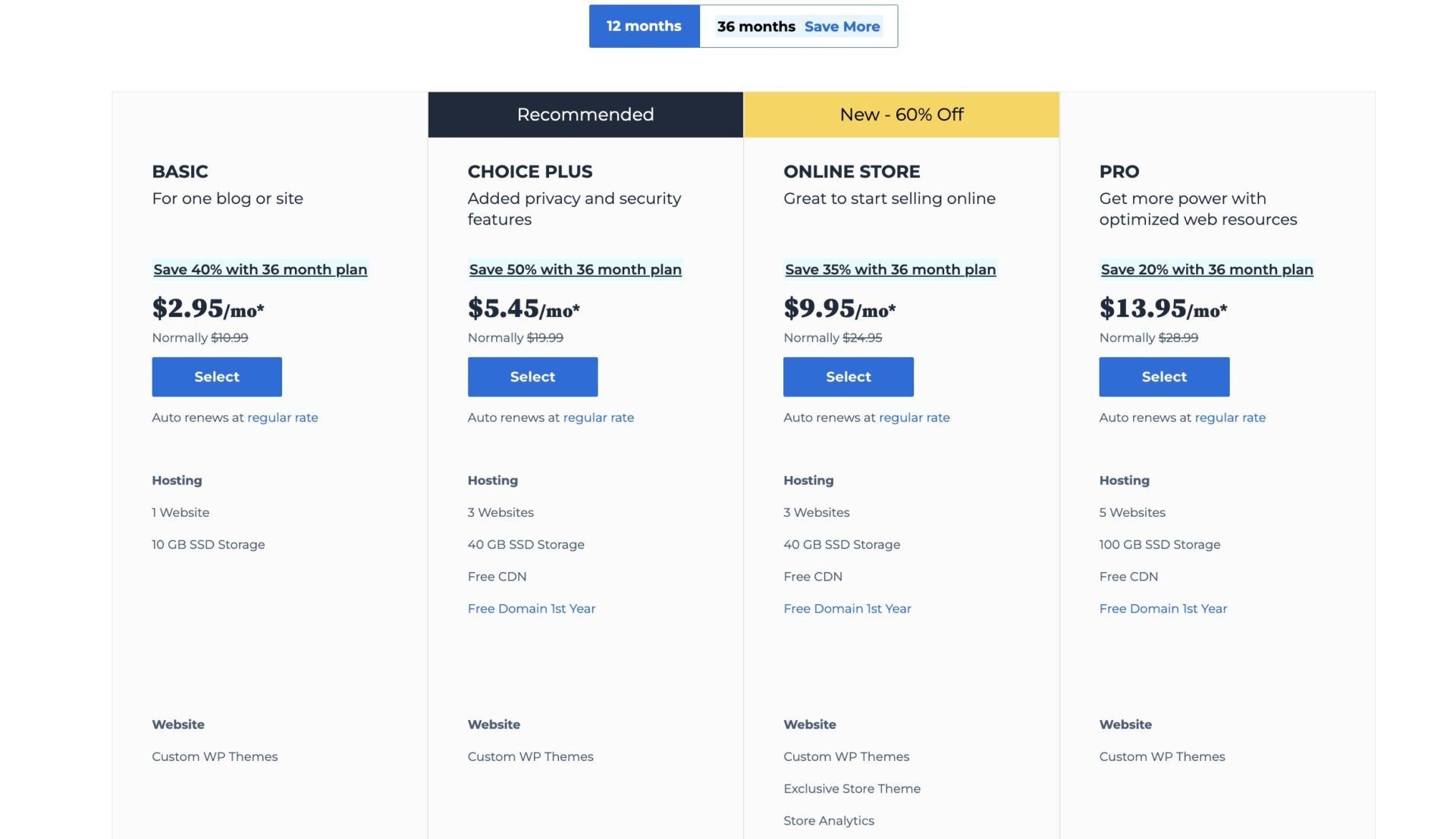
From our findings, Bluehost’s pricing starts at around $3 per month and renews at almost $11 monthly for a yearly subscription. This plan is called Basic and it includes a free SSL certificate and 10 GB SSD of storage. You can host only one website on the account.
In our opinion, this plan is not worth the pricing with these features, especially at an $11 monthly renewal price. As a result, we don’t recommend it. Considering the pricing and features of the other plans in the shared hosting category, they follow the same pattern.
The baffling part, however, is that the web host does not give significant discounts when you choose a 36-month plan. Instead, it increases the monthly cost ($5 per month for the Basic plan) and tries to justify that you already got the discount, nonetheless. While this is technically true, it is not enough.
Conversely, InMotion pricing starts at about $4 per month and renews at only $10 monthly for a yearly subscription. This plan includes free SSL certificates, 100 GB SSD of storage space, 10 free email addresses, DDoS protection, hack & malware protection, unlimited bandwidth, free WordPress site builder, and 2X performance & speed.
It can even host up to 2 websites. Unlike Bluehost, InMotion provides better discounts on its plans when you choose a longer subscription period. For instance, choosing the 3-year subscription period for InMotion’s starter plan, Core, will bring the initial monthly pricing below $3 and renew at less than $9 per month afterward.
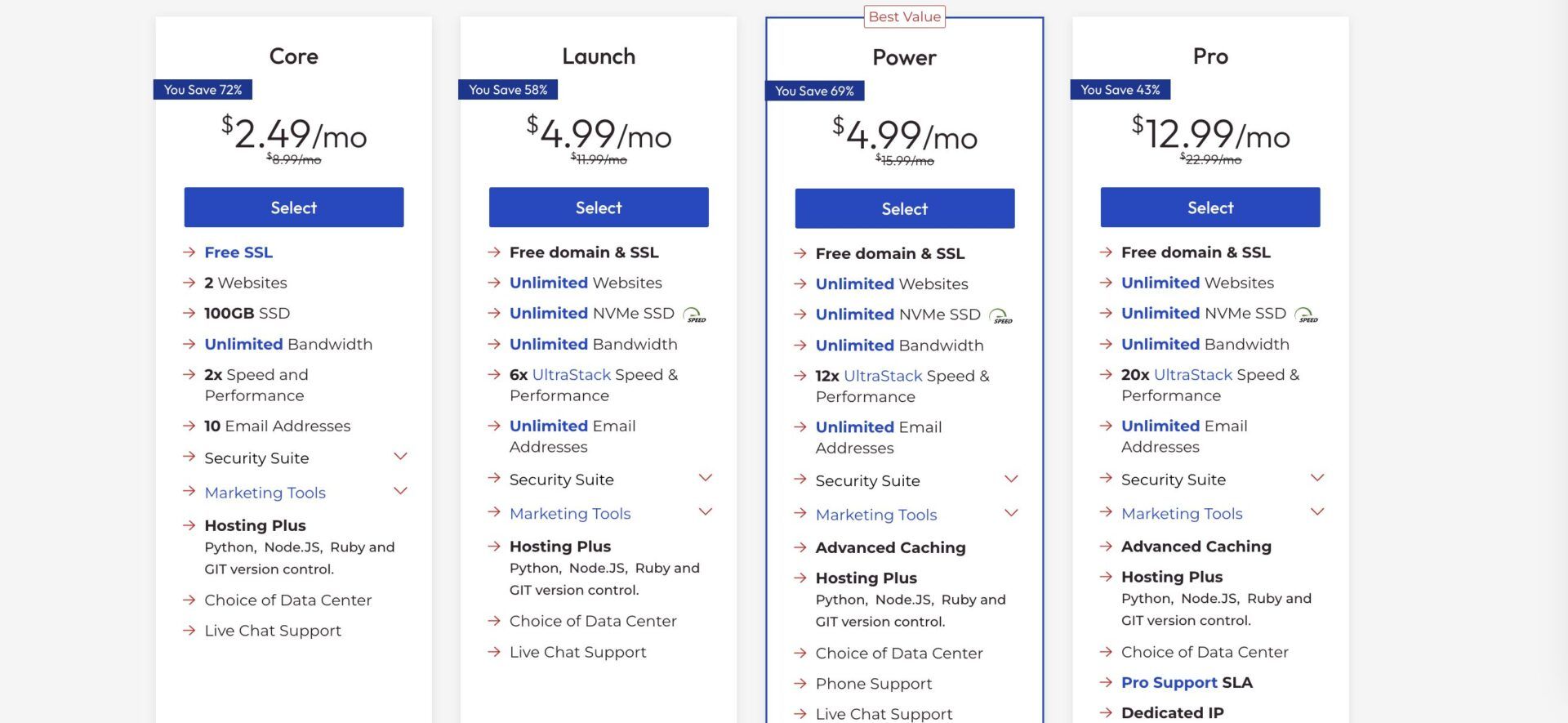
So, in this Bluehost vs InMotion Hosting comparison regarding the pricing of the plans, the latter is clearly more affordable with better value for money.
Coming to domains, both web hosts are also reliable registrars. Bluehost allows you to register several top-level domains (TLDs) at affordable prices. The popular .com domain extension for instance costs about $13 yearly on Bluehost.
This doesn’t include domain privacy protection and that costs an additional $12 annually. However, if you purchase a hosting plan that includes free domain name privacy, you will not have to pay for it anymore. All other packages except for Basic in the shared hosting type include free domain privacy.
Note: Domain privacy & protection is a service that allows you to hide your domain contact information from public records, especially the WHOIS database. This helps to prevent spam and identity thefts, and of course, protect the privacy of your personal information.
On the other hand, InMotion lets you register only .com, .net, .org. .us, .biz, and .info domain extensions for about $12 yearly. This subscription does not include free domain privacy either and it costs $13 yearly. Unlike Bluehost, InMotion does not give the free domain privacy feature on any of its plans. Hence, you will have to purchase it if you host your domain name with them. As a result, buying a domain with privacy protection is cheaper on Bluehost than InMotion.
Bluehost Pricing
Having discussed the Basic plan, here are the other shared hosting packages at Bluehost with their pricing and features:
- Choice Plus: It costs about $5 per month; renews at about $20 monthly. The plan includes free CDN, free domain privacy, a free domain name for the first year, 40 GB SSD of storage space, and malware scanning. What’s more, you will get automated daily backups for the first year and free SSL. The plan can host only 3 websites.
- Online Store: It costs almost $10 monthly; renews at about $25 per month. Aside from the features of the Choice Plus plan, it includes some eCommerce functionalities. You will get a store theme, store analytics, and eCommerce plugins that are worth over $450. Additionally, you will get the automated daily backup feature, fully.
- Pro: It costs around $14 monthly; renews at about $29 per month. In addition to the Choice Plus plan features, it includes 100 GB SSD storage and automated daily backup with no expiry date. You can host up to 5 websites.
InMotion Hosting Pricing
InMotion has four plans under the shared hosting type. Let’s discuss briefly the pricing and features of the other packages.
- Launch: It costs around $7 per month; renews at about $14 monthly. Aside from Core features, it includes unlimited free email hosting, a free domain name for the first year, and unlimited NVMe SSD. You will also get 6X UltraStack speed & performance and be able to host up to 25 websites.
- Power: It costs almost $7 monthly and renews at about $18 per month. In addition to Launch features, it includes the capacity to host unlimited websites, 12X UltraStack speed & performance, advanced caching, and phone support.
- Pro: It costs about $15 per month; renews at $25 monthly. You will get 20X UltraStack speed & performance, pro support SLA, a dedicated IP address, and the Power plan features.
In our opinion, the winner of the InMotion vs Bluehost comparison is the former. This is because InMotion is better in terms of pricing and features across all plans. For instance, while InMotion allows hosting unlimited websites and accessing unlimited storage space, the highest number of sites you can host on Bluehost’s shared hosting plans is 5, and storage is capped at 100 GB.
| InMotion | Bluehost | |
|---|---|---|
| Shared Hosting | $3.49 - $14.99 | $2.95 - $13.95 |
| WP Hosting | $4.49 - $16.99 | $2.95 - $13.95 |
| VPS Hosting | $14.99 - $74.99 | $29.99 - $69.99 |
| Dedicated Server | $89.99 - $739.99 | $89.98 - $119.88 |
Which Host Has More and Better Features, Bluehost or InMotion?
The availability of features is another thing we are considering in our Bluehost vs InMotion Hosting comparison for 2025. From our experience, it is better to choose a web host that has the features you need for your website included in its hosting packages. Otherwise, you will have to employ the use of third-party tools.
At the same time, even when a web host includes these features in its packages, we should ensure that they are not add-ons since they will increase our overhead costs unnecessarily. Thus, if for example, we have to choose either Bluehost or InMotion when they provide the same features, the right choice will be the one that gives the features at no extra cost.
Bluehost Features
Bluehost isn’t known for offering essential features, although it is not bad either. The web host provides very few built-in features and tries to sell others as add-ons unless you purchase a higher plan. Despite this, there are still some features that are neither available built-in nor as add-ons.
Here are some of the features you can enjoy by hosting your website with Bluehost:
- Free domain for the first year & domain privacy protection (available on all shared plans except for Basic)
- Free SSL and email hosting
- SSD storage with RAID-10 array
- Dedicated resources and unmetered bandwidth
- WordPress staging tools
- Linux servers, MySQL databases, SSH access, and FTP accounts
- One-click app installer
- Malware scanning via SiteLock add-on
- Automated backups via CodeGuard add-on
- Root access & cPanel
InMotion Hosting Features
Unlike Bluehost, InMotion has a lot of features that make it a unique and highly resourceful web host. The features are built-in and they are very crucial to the growth of any website.
InMotion also hoards some features in order to influence getting an add-on. However, it does not attempt to hoard any feature in order to make users upgrade to a highly-priced plan. In our opinion, all the plans and features are worth their respective prices.
Here are some of the features available at InMotion:
- Free domain registration for the first year
- Free website migrations with an automated tool
- Unlimited NVMe SSD storage for fast data transfer speed
- Unlimited bandwidth and databases
- Free SSL certificates and email hosting
- UltrsStack performance and advanced caching
- Staging tool, free website builder, & one-click app installer
- Multiple data centers
- 24/7 customer support
- Up to 90-day money-back guarantee
Other notable features include hack & malware protection, SSH access, backup manager, WP-CLI, spam experts, and safe application rollback.
Judging from the features of each host as shown above, the winner of the InMotion Hosting vs Bluehost duel in this category is the former.
Which Host Performs Better, Bluehost or InMotion?
One of the most important things to know when deciding which web host to trust with your website is performance. Web hosts use different technologies to build their servers and hosting environments. As a result, they tend to deliver different levels of performance too.
This is why there is a need to ensure that the web host we trust with our business website can deliver enough performance to power our projects effectively. So, we will do a Bluehost vs InMotion Hosting juxtaposition in terms of speed, uptime, and load strength.
InMotion Hosting vs Bluehost Speed Tests Comparison
Speed is the principal performance test a website must pass because it can be deemed as good. A website’s loading speed influences a lot of factors like bounce rates, return visits, SEO performance, conversation rate, user experience, etc.
When the loading speed of a website or web page is great, the influence on these factors is positive. Thus, the website will experience rapid growth in these areas and generally. Similarly, when a site has a bad loading speed, it will struggle to perform well in other aspects.
As a result, we will do a Bluehost vs InMotion comparison to know which of the web hosts delivers better speed performance.
In order for us to understand the results of our tests, let’s see some of the metrics in use, what they mean, and the expected values.
- Time to First Byte (TTFB): This metric measures how long it takes your server or website to send the first response or packet data to the query of the user’s browser. It means the server connection time. Ideally, this should be 0.8 s or less.
- First Contentful Paint (FCP): This is how long it takes the first visible item on your web page to fully display on a user’s screen. Ideally, FCP should be less than 1.8 s.
- Largest Contentful Paint (LCP): This metric calculates how long it takes the largest visible item on your web page to fully display on a user’s screen. It could be a big hero image, button, text, etc. A good FCP should be 2.5 s or less.
- Cumulative Layout Shift (CLS): This metric measures how stable your web page is using mobile responsiveness and the arrangements of your HTML, CSS, and JS elements. An ideal CLS is 0.01 or less.
- Loading time: This measures how long it takes your web page to fully load or display the items clearly for a user to see. An ideal web page should not take longer than 3 seconds to load on average.
Bluehost Speed Test
Our Bluehost speed analysis was done using GTmetrix. We bought the Basic plan for our test website and installed WordPress on it. Afterward, we activated the Neve theme and imported the content of one of its starter websites. Without any customization or optimization, we commenced our tests.
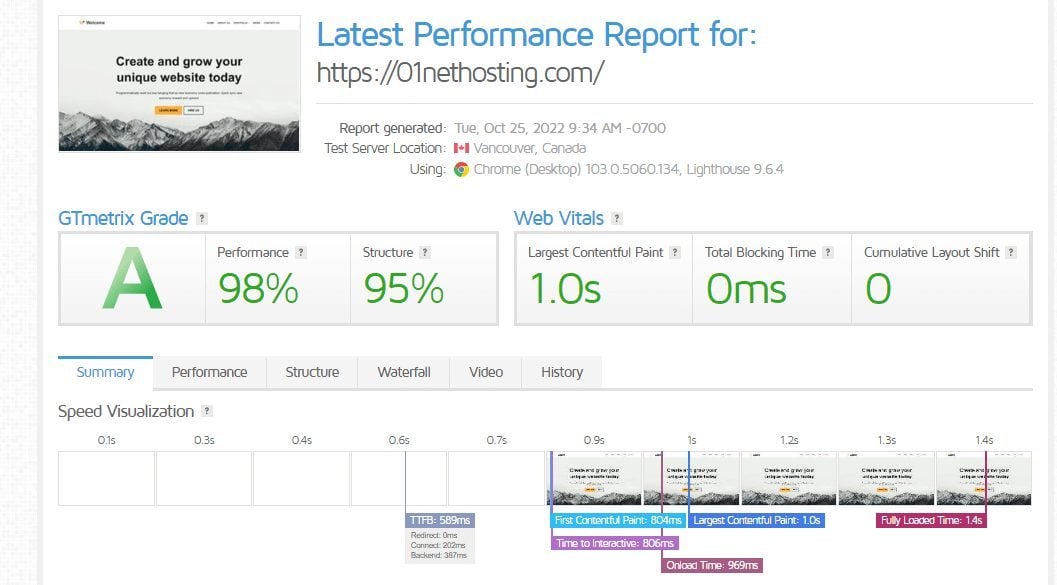
Here is the summary of the results of Bluehost speed tests via GTmetrix:
- TTFB: 589 ms
- FCP: 804 ms
- LCP: 1.0 s
- CLS: 0.00
- Loading time: 1.4 s
Even though the above results are not bad, they didn’t meet the expectations we had for Bluehost. Before we comment further, let us see how InMotion performs as well.
InMotion Hosting Speed Test
Our InMotion Hosting speed test followed the same path as Bluehost’s. We purchased the Core plan and installed WordPress on the website. Afterward, we set the same condition as we did for Bluehost and commenced our tests. This was done in order to ensure that there is a fair comparison of the two web hosts.
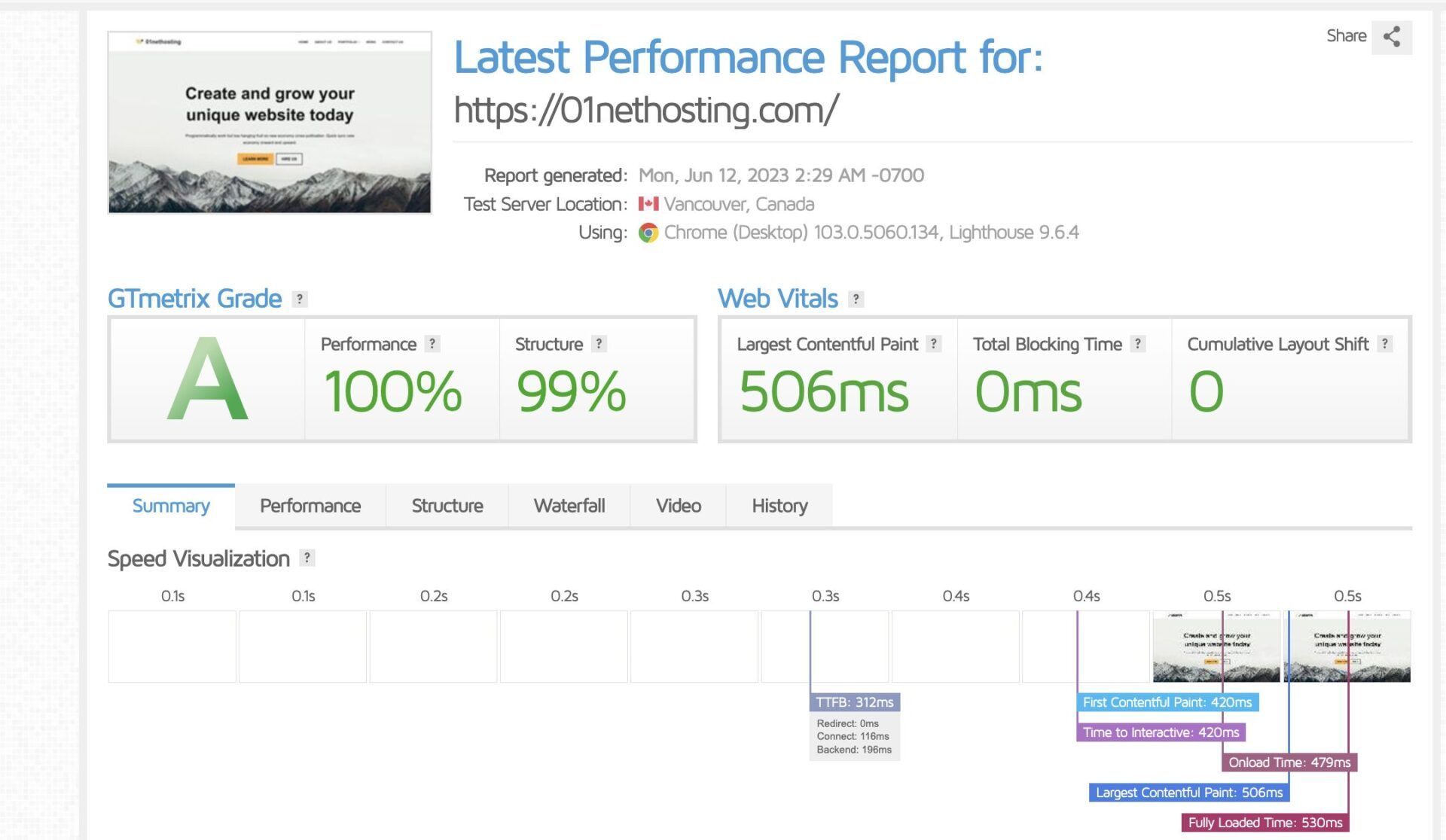
Here is a summary of our InMotion GTmetrix speed test results:
- TTFB: 312 ms
- FCP: 420 ms
- LCP: 506 ms
- CLS: 0.00
- Fully loaded time: 530 ms
From these results, we can see that InMotion delivered an outstanding performance in the tests. It shows that you can expect your InMotion website to load within one second.
By comparison, while an InMotion website loads in 530 ms, a similar Bluehost site under the same conditions will load in about 1400 ms or 1.4 s. This means Bluehost is almost 2 times slower than InMotion. So if these two websites are competing for the same audience on search engine results pages (SERPs), the InMotion site with faster speed will rank better. Besides, users will prefer to visit the InMotion website over the Bluehost site.
Therefore, in the Bluehost vs InMotion comparison regarding website loading speed, the winner is the latter.
Bluehost vs InMotion Hosting Uptime Tests: Which is More Reliable?
Another important performance test we considered in our InMotion Hosting vs Bluehost duel for 2025 was uptime. Uptime refers to the total amount of time a website can stay online for a particular period. For instance, if a website stays online without downtime for 24 hours, we can say that it has 100% uptime. Similarly, if it was down for 12 hours out of 24 hours, its uptime is 50%.
Uptime defines the reliability of a website or brand. A website that has good uptime assures customers that it will always be online and available to tend to their needs. For an online store, it means the customers can perform transactions at all times. This increases loyalty, trust, conversation rates, revenue, customers, profits, etc. Such a website will even be able to steal visitors from competitors.
On the other hand, a website with bad uptime is not always online or experiences downtime enough for users or visitors to notice. As a result, it will record a drop in revenue, visitors, SEO performance, conversation rates, etc. There will be an increase in bounce rates as well.
Hence, want to do a Bluehost vs InMotion Hosting comparison to determine which of the web hosts to choose for better site uptime.
For this, we used the uptime data that has been mined by Pingdom for the two hosting providers. According to Pingdom, Bluehost had 99.963% uptime within 6 months while InMotion had 99.995% in the same period. As a result, InMotion is the more reliable web host.
Go to InMotion Hosting Website
Load and Response Time Tests
Another performance aspect in which we had our InMotion Hosting vs Bluehost comparison was load and response time. Load and response time refers to how your server responds to traffic at a particular time.
Every server has its own capacity and a limit where it can keep working at that capacity. For instance, a server might be able to handle 50 visitors at once and deliver the same speed and performance but won’t be able to handle 100 visitors. At the same time, another server might be able to handle 100 visitors, but not 200. This difference sets the servers apart and dictates their purpose.
The aim of the Bluehost vs InMotion Hosting duel in terms of load and response time is to see which of them can handle a high-traffic website without declining performance or downtime. This way, you will know which one to choose for your resource-demanding website projects.
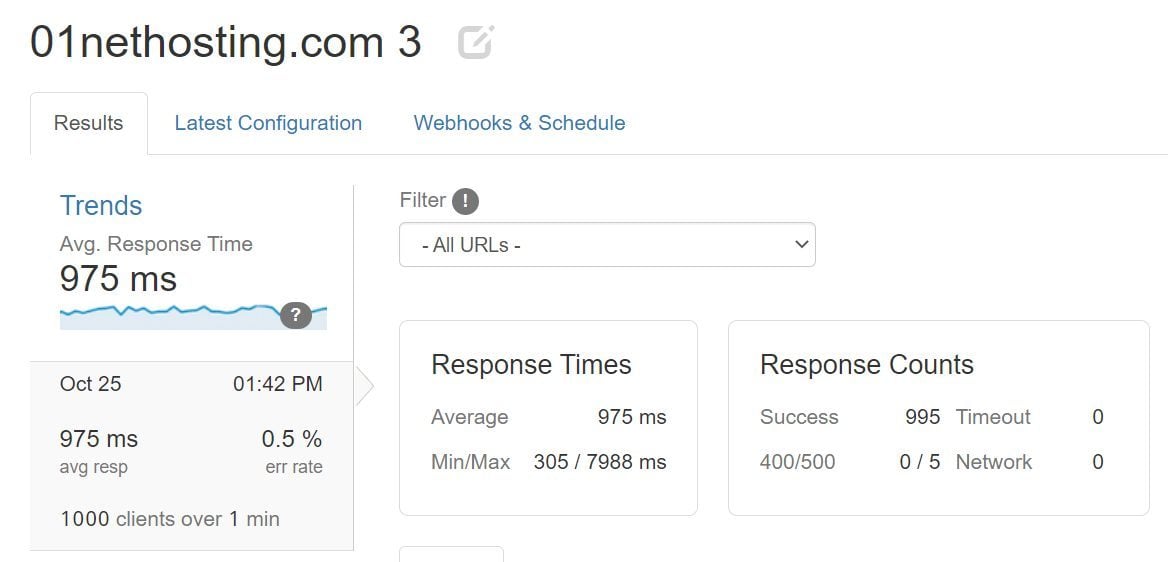
Our load and response time comparison involved sending virtual visitors to our test websites for both hosts under similar conditions. We sent 1000 visitors to our InMotion test website and recorded the fastest, average, and slowest response times to be 59 ms, 413 ms, and 1795 ms, respectively. However, this is no good news as we had a 91.3% error rate. This indicates that more than 90% of the 1000 visitors that tried to visit our website at that time couldn’t due to connection timeout or downtime.
In contrast, we recorded for the Bluehost website the fastest, average, and slowest response times at 305 ms, 975 ms, and 7988 ms, respectively. This shows that the server took up to 8 seconds to respond to connections. As a result, it also failed the test.

Another look at how the servers respond to 50 visitors in under one minute revealed that InMotion performed better in that aspect. InMotion had the fastest, average, and slowest response times for 50 visitors at 449 ms, 475 ms, and 776 ms, respectively.
In comparison, Bluehost had the fastest, average, and slowest response times at 429 ms, 529 ms, and 2025 ms respectively. This means that even though InMotion is not built for high-traffic sites, it can handle medium-traffic sites better than Bluehost. Thus, we will have to consider this aspect of the Bluehost vs InMotion duel a tie.
Bluehost vs InMotion Hosting: Control Panel & User Experience
Account management is a very important aspect of hosting a website. Every now and then, a website owner will have to make some changes from their hosting account to their site. This will require having a panel that has all the necessary controls needed to customize the settings of your website to what you want. Our aim for the Bluehost vs InMotion Hosting comparison in this aspect is to determine which of the web hosts provides an easier-to-use control panel.
Bluehost Control Panel & Management
Bluehost has an intuitive dashboard that was built for easy navigation. The dashboard has a clean interface that includes a sidebar. This sidebar serves as the main menu for the controls of your site or account. From the sidebar, it is possible to access Domains, Emails, Sites, Bluehost Marketplaces, and Advanced settings.
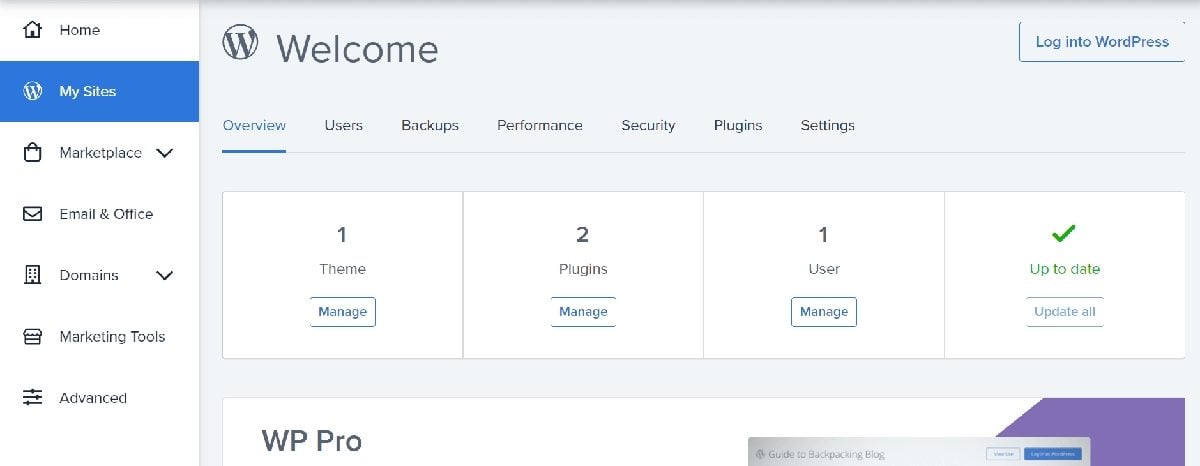
The Bluehost dashboard serves as a control panel in the sense that it has some built-in settings you can configure from it. However, from our experience, this is meant for WordPress websites. These built-in settings include the backup, performance, plugins, themes, marketing, and user controls of your WordPress site.
In order to fill the void created by the settings that are not present, Bluehost integrates cPanel into its dashboard. Thus, you can access some settings on the cPanel with direct links from the Bluehost dashboard. Some of these settings include File Manager, FTP, Databases, and phpMyAdmin.
Aside from the fact that the cPanel is filled with unnecessary functionalities that might be confusing to beginners, the integration is very smooth. You may also have to get over the redirections from the Bluehost website when you access some cPanel settings and the few occasions when you will be logged out automatically.
InMotion Hosting Control Panel & Management
According to our findings, InMotion has two control panels. It has a proprietary control panel called InMotion Central (Platform i) and the Account Management Panel (AMP).
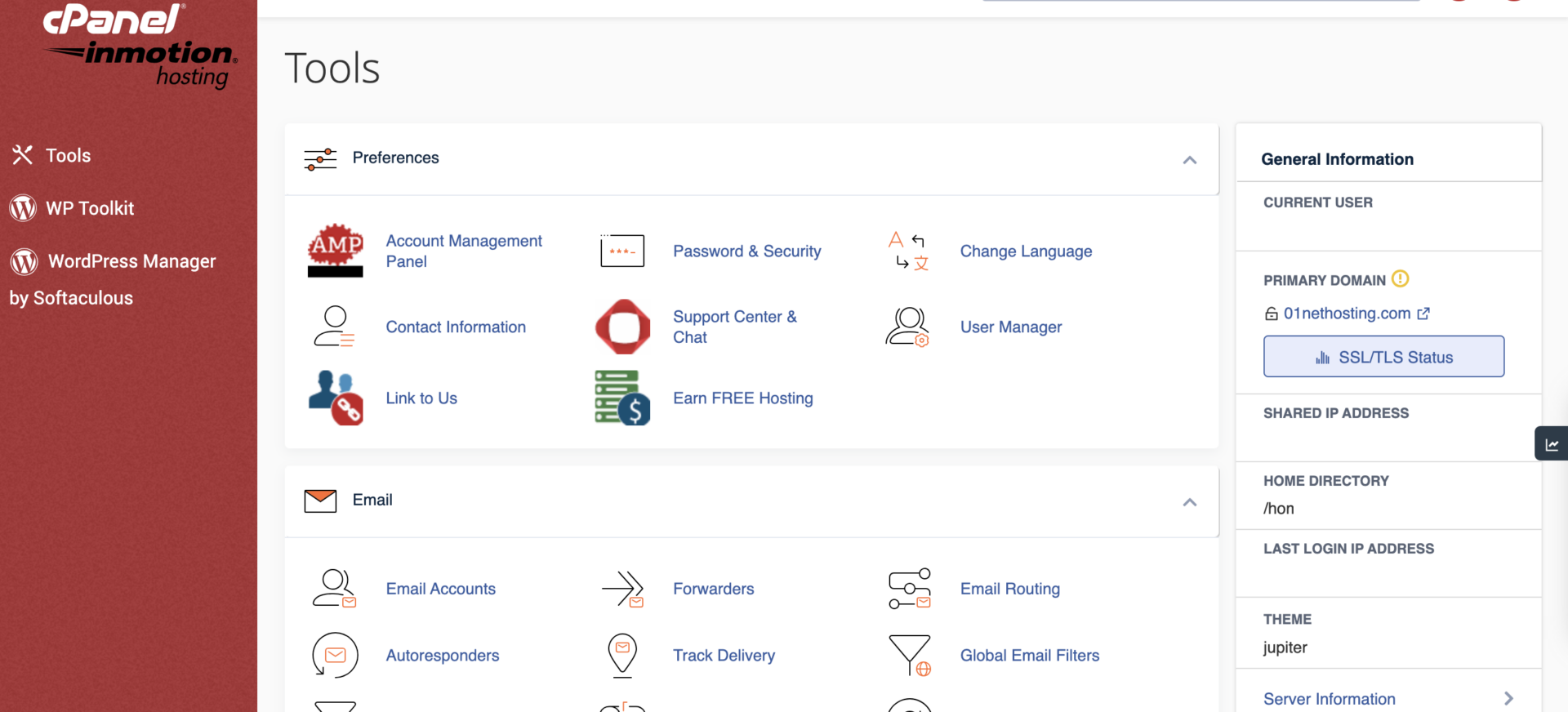
The InMotion Central control panel (Platform i) is available only on the Cloud WordPress plans. This panel has been optimized for the control of WordPress websites that all the options is provides are only WP-related.
As a result, it helps a user easily manage their WordPress site without distraction. What we love the most about Platform i is that it has a lot of features. Some notable ones are Playground Environments for staging, the Optimize tool for performance tuning, and the automated WordPress website migrator tool.
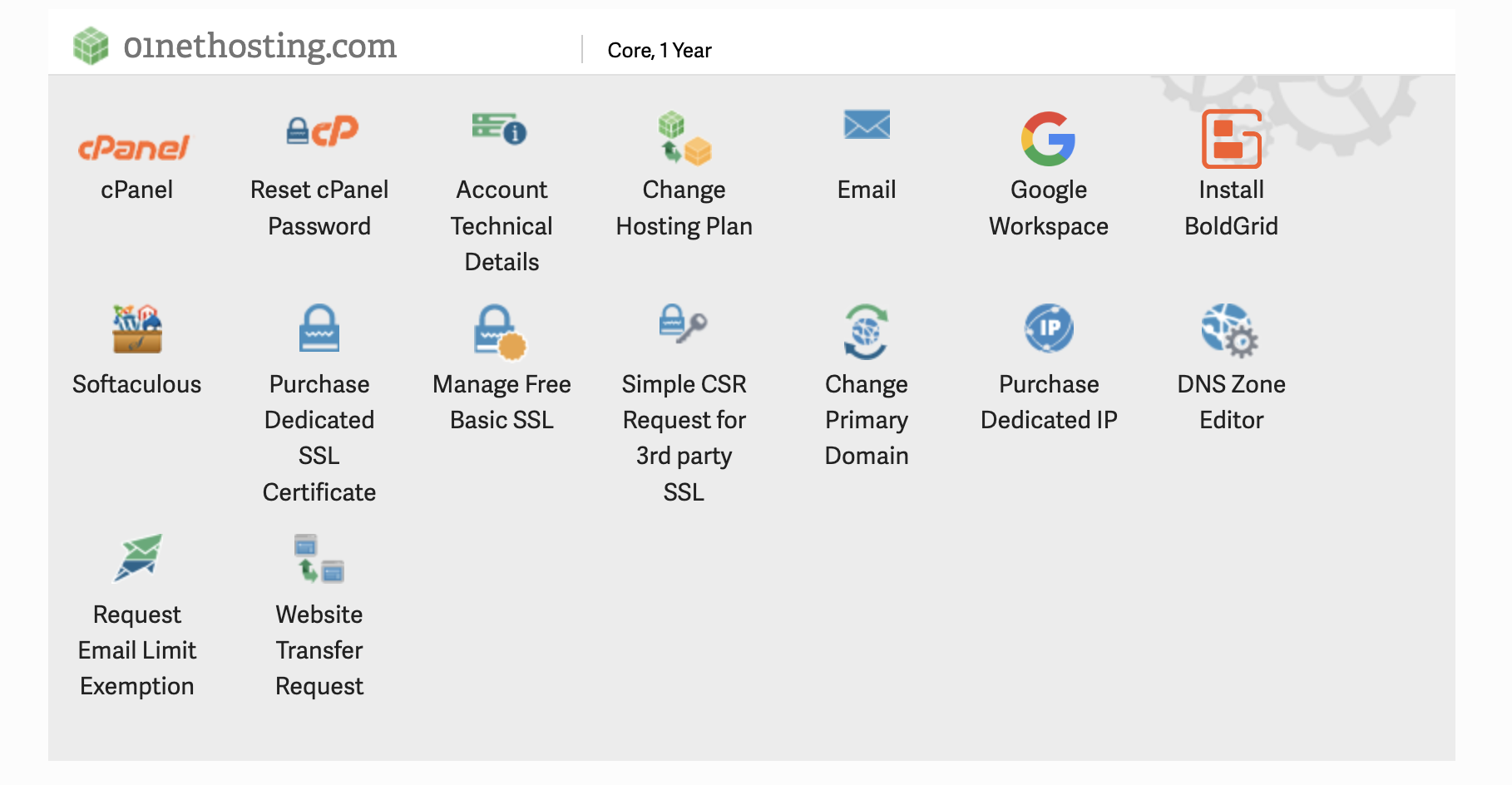
The AMP was designed for all other plans apart from the Cloud WordPress packages. AMP is not a proprietary control panel. Rather, it integrates with the cPanel. However, unlike Bluehost’s dashboard, InMotion’s AMP has a better or more stylish interface. Instead of providing a link that loads the cPanel on AMP, InMotion designed its interface in such a way that all the important settings you need to access have direct links on the homepage.
They are arranged in the form of tiles or icons and anyone can easily access any relevant setting by clicking them. Some of the available controls that you can access directly from the AMP are the Softaculous app installer, DNS Zone Editor, AutoSSL installer, cPanel homepage, etc. You can even reset your cPanel password easily there.
Not only that, but InMotion has customized the cPanel. As a result, there are some settings of your InMotion account that you can access from the cPanel as well. In fact, you can even go back to the AMP directly from the cPanel using a link. Managing other account settings with the AMP is also great.
From the explanations above, the winner of the Bluehost vs InMotion Hosting comparison for 2025 in terms of control panel and ease of use is the latter. Aside from the fact that InMotion has Platform i which is specialized for WordPress websites, it integrates cPanel better than Bluehost as well. It’s also worth noting that it’s one of the best hosts for cPanel.
Build Your Website with InMotion Hosting
InMotion vs Bluehost: Which is More Secure ?
Security is another area we did our InMotion Hosting vs Bluehost comparison for 2025. When it comes to picking the web host that will power your website either for fun or business, security should be a priority. This is because irrespective of the type of website, attackers or hackers will have always ulterior motives to steal data and files. Sometimes, human error could also make us introduce malware into our website through the files or codes we copy and upload to the server. As a result, it is important to ensure that the web host we entrust our website with has enough security measures in place. So, is it Bluehost or InMotion Hosting that provides better security? Let’s find out!
A look into the security setup at Bluehost revealed that the web host is not very reliable in that aspect. From our findings, the only sure security measure that Bluehost puts into place is the provision of free SSL certificates. This is available to you on the Basic plan. Its other security features are offered by third-party companies. Thus, you will have to purchase them as add-ons in order to add them to your account.
If you don’t want to purchase add-ons, you may need to upgrade to a plan that has the features. Although, after analyzing the plans and features, each of them requires the purchase of an add-on for one security feature or the other. Some of the security features you can get from Bluehost add-ons are daily backups and malware scanning.
On the other hand, InMotion Hosting provides better security features. The web host has many in-built security features put in place to protect your website and server against malicious attacks and malware. It has free SSL certificates, DDoS protection, web application firewalls (WAF), hack & malware protection, automated backups, and spam experts. Aside from the automated backup manager, all other security features are free on all plans.
Considering the fact that InMotion offers even more affordable hosting plans, it is our choice for better website security between the two. Thus, the winner of our InMotion Hosting vs Bluehost security comparison for 2025 is the former.
| InMotion | Bluehost | |
|---|---|---|
| SSL Certificate | Yes | Yes |
| Automated Backups | Yes | Yes |
| DDoS Protection | Yes | No |
| Firewalls | Yes | No |
| Brute-Force Protection | Yes | No |
| Malware Scanning | Yes | Yes |
Customer Support: Bluehost vs InMotion Hosting
Customer support is also crucial when choosing a web host. This is one of the reasons we why considered it in our InMotion Hosting vs Bluehost duel for 2025.
What determines a good web host in terms of customer support is a lot. A non-exhaustive list of some of the factors includes available support channels, response times, support hours, competency of the agents, willingness to assist, satisfaction ratings, etc. So, let us see if it is Bluehost or InMotion that provides better customer support.

Bluehost provides 24/7 support via live chats and phone calls. From our experience, Bluehost’s live chat channel is a fast way to connect with the support team and get assistance on any issue you may have. Most of the time, you will get fast and very helpful responses.
Nonetheless, it is not always a good experience. There are several times when you will not be able to get in contact with any agent via live chat or phone calls. Thus, you will have to drop a message and wait forever for a reply to arrive. This happens, despite the fact that the web host promises 24/7 support. Besides, most of the agents are not WordPress experts and they don’t even have much experience with Bluehost products or services.
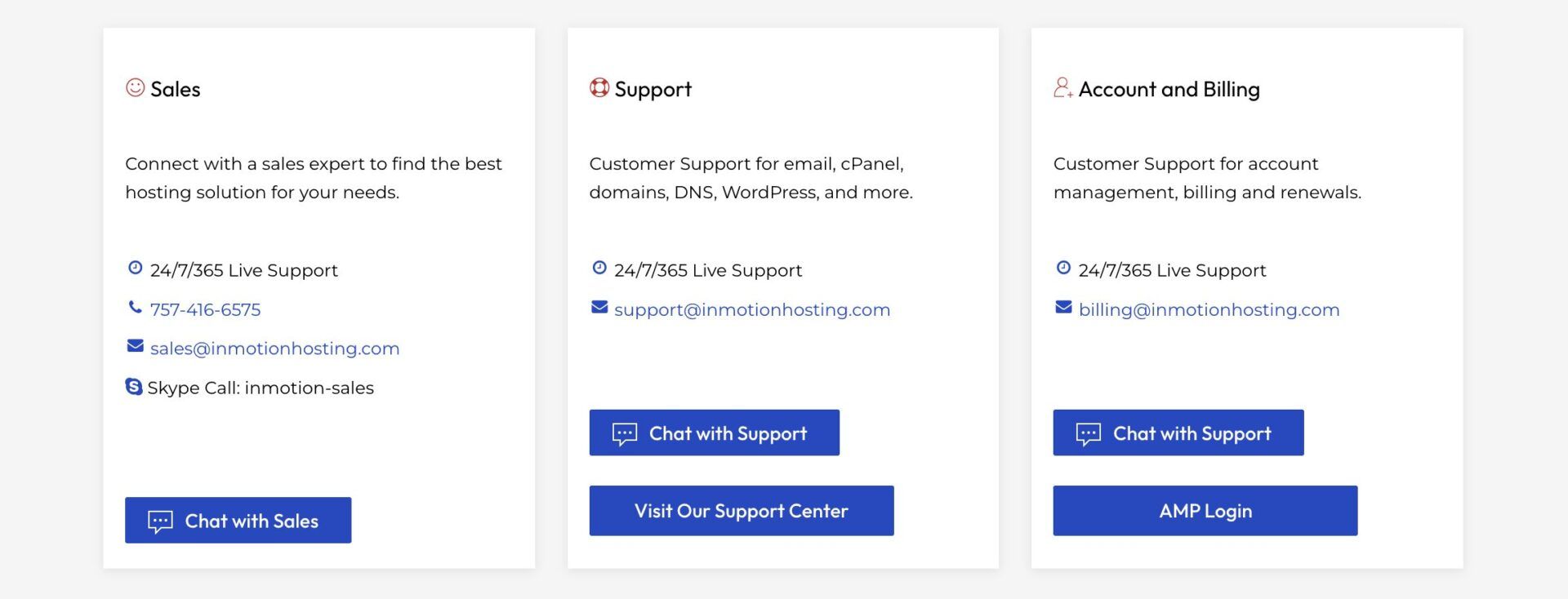
In contrast, InMotion provides support via live chats, tickets, and phone calls (757.416.6575). The customer service department at InMotion is available for support only from 9 AM – 9 PM ET, Monday – Friday via phone or chat while the technical support team is available 24/7. Drawing from our experience, the support team at InMotion is filled with competent agents, unlike Bluehost. They reply to messages quickly and they know the products they are providing support for, deeply.
Therefore, the winner of the Bluehost vs InMotion Hosting duel in terms of customer support is the latter. InMotion presents more support channels with better availability that will give you peace of mind.
Bluehost or InMotion: Which Has a Better Money-back Guarantee?
Money-back guarantee is also a great way to know a reliable web host. A money-back guarantee gives customers the assurance that they would get a refund if they cancel their subscriptions due to dissatisfaction within the stated period. So, it shows the level of confidence of the web host in the services it provides and lets you try the services risk-free as well.
Bluehost has a 30-day money-back guarantee. This guarantee covers all hosting plans canceled within 30 days of initial purchase and not renewals. In order to get a refund for renewals, it must be canceled at least 15 days prior to the commencement of the billing period. Bluehost offers no refunds for monthly subscriptions, add-ons, and domains. There is no partial refund either.
Conversely, InMotion Hosting has a 90-day money-back guarantee on its 6-month and upwards plans. For monthly plans, you will get only a 30-day money-back guarantee. Refunds on domain names are also possible within the first 96 hours of registration.
By comparing InMotion and Bluehost in terms of money-back guarantee, we can see that the winner is InMotion.
Conclusion: Which is Better? Bluehost or InMotion Hosting
After comparing both hosts side-by-side using the main yardsticks that determine a good web host in 2025, it is quite obvious that InMotion Hosting conveniently surpasses Bluehost.
Thus, InMotion is one of the best Bluehost alternatives that you can use to host your website conveniently without worries. It beat Bluehost in nine out of ten rounds, the tenth being a draw.
